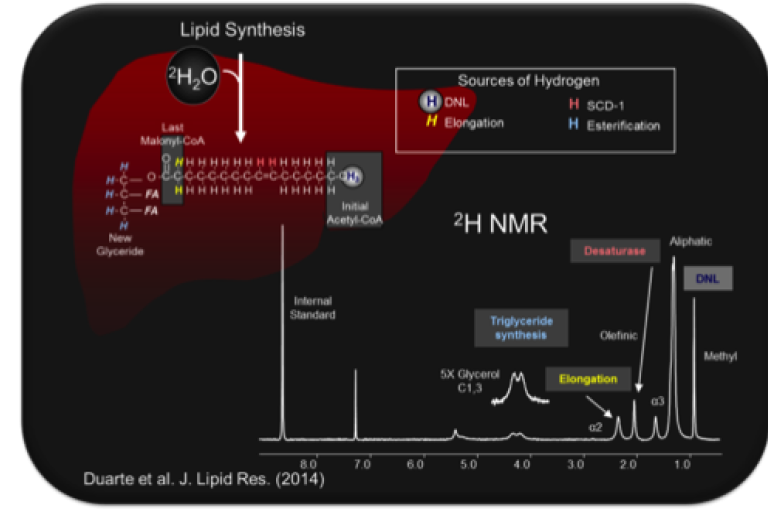
Deuterium accumulates in lipid species according to their rate of synthesis. This accumulation can be observed in multiple sites of a lipid molecule by MR, and this information can be used to determine rates of lipid biosynthesis.
Tracer approaches for examining metabolism are critical to understanding the metabolic mechanisms disease. By using stable isotope tracers, one can observe the activity, or flux, of a specific metabolic pathway, and this information can be used to determine whether that pathway is altered by disease.
An important objective is to design tracer approaches to be used in both humans and in laboratory models so that clinical significance and mechanisms can be tested.
We have developed, adapted, and validated tracer approaches to study metabolic mechanisms in mice and humans. For example, a method that uses deuterated water (a non-radioactive, non-toxic, isotope tracer) was developed to measure flux through multiple pathways of lipid synthesis using a single NMR analysis of blood or tissue.
Some other approaches include the development or application of 13C NMR measurements of TCA cycle metabolism, 2H NMR analysis of gluconeogenesis, and MS analysis of ketogenesis.
References
Burgess SC, Merritt ME, Jones JG, Browning JD, Sherry AD, Malloy CR. Limitations of detection of anaplerosis and pyruvate cycling from metabolism of [1-(13)C] acetate. Nature Med. 2015;21(2):108-9. PMID: 25654596.
Duarte JA, Carvalho F, Pearson M, Horton JD, Browning JD, Jones JG, Burgess SC. A high-fat diet suppresses de novo lipogenesis and desaturation but not elongation and triglyceride synthesis in mice. J Lipid Res. 2014;55(12):2541-53. PMID: 25271296.
Browning JD, Burgess SC. Use of 2H2O for estimating rates of gluconeogenesis: determination and correction of error due to transaldolase exchange. Am J Physiol Endocrinol Metab. 2012;303(11):E1304-12. PMID: 23032685.
Merritt ME, Harrison C, Sherry AD, Malloy CR, Burgess SC. Flux through hepatic pyruvate carboxylase and phosphoenolpyruvate carboxykinase detected by hyperpolarized 13C magnetic resonance. PNAS. 2011;108(47):19084-9. PMID: 22065779.
Bock G, Schumann WC, Basu R, Burgess SC, Yan Z, Chandramouli V, et al. Evidence that processes other than gluconeogenesis may influence the ratio of deuterium on the fifth and third carbons of glucose: implications for the use of 2H2O to measure gluconeogenesis in humans. Diabetes. 2008;57(1):50-5. PMID: 17934142.
Mendes AC, Caldeira MM, Silva C, Burgess SC, Merritt ME, Gomes F, et al. Hepatic UDP-glucose 13C isotopomers from [U-13C]glucose: a simple analysis by 13C NMR of urinary menthol glucuronide. Magn Res Med. 2006;56(5):1121-5. PMID: 17036288.
Burgess SC, Jeffrey FM, Storey C, Milde A, Hausler N, Merritt ME, Mulder H, Holm C, Sherry AD, Malloy CR. Effect of murine strain on metabolic pathways of glucose production after brief or prolonged fasting. Am J Physiol Endocrinol Metab. 2005;289(1):E53-61. PMID: 15797985.
Jin ES, Jones JG, Burgess SC, Merritt ME, Sherry AD, Malloy CR. Comparison of [3,4-13C2]glucose to [6,6-2H2]glucose as a tracer for glucose turnover by nuclear magnetic resonance. Magn Res Med. 2005;53(6):1479-83. PMID: 15906303.
Jin ES, Jones JG, Merritt M, Burgess SC, Malloy CR, Sherry AD. Glucose production, gluconeogenesis, and hepatic tricarboxylic acid cycle fluxes measured by nuclear magnetic resonance analysis of a single glucose derivative. Anal Biochem. 2004;327(2):149-55. PMID: 15051530.
Burgess SC, Nuss M, Chandramouli V, Hardin DS, Rice M, Landau BR, et al. Analysis of gluconeogenic pathways in vivo by distribution of 2H in plasma glucose: comparison of nuclear magnetic resonance and mass spectrometry. Anal Biochem. 2003;318(2):321-4. PMID: 12814639.
Burgess SC, Weis B, Jones JG, Smith E, Merritt ME, Margolis D, et al. Noninvasive evaluation of liver metabolism by 2H and 13C NMR isotopomer analysis of human urine. Anal Biochem. 2003;312(2):228-34. PMID: 12531210.
Burgess SC, Carvalho RA, Merritt ME, Jones JG, Malloy CR, Sherry AD. 13C isotopomer analysis of glutamate by J-resolved heteronuclear single quantum coherence spectroscopy. Anal Biochem. 2001;289(2):187-95. PMID: 11161312.